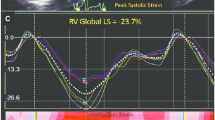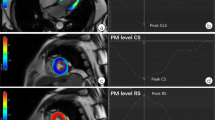Abstract
The exact role of papillary muscle infarction (PMI) during the acute phase of acute ST-segment elevation myocardial infarction (STEMI) is not well understood, as existing data on the impact of PMI location is conflicting. We hypothesized that infarction of the posteromedial papillary muscle (PM-PMI) as determined by cardiac magnetic resonance imaging might be associated with an increased incidence of mitral valve regurgitation in the first week after STEMI. 242 patients with first STEMI underwent a late-enhancement (LGE-) cardiac magnetic resonance imaging within a median of 2 (IQR 2–5) days and echocardiography within 3 (IQR 2–5) days after primary angioplasty for the index event. PMI was scored based on short axis slices (AL-PMI: anterolateral PMI, PM-PMI, AL/PM-PMI: AL- and PM-PMI). Patients with PM-PMI had significantly higher odds (OR 2.62, p < 0.01) for the occurrence of mitral regurgitation than patients with no-PMI, AL-PMI or AL/PM-PMI. Furthermore, advanced age, non-anterior infarct location and longer pain-to-balloon time were identified as risk factors for the occurrence of mitral regurgitation. Binary logistic regression analysis revealed that PM-PMI is a predictor of mitral regurgitation independent of infarct location and age (OR 2.229, CI 1.078–4.903, p = 0.031). PM-PMI as determined by cardiac magnetic resonance imaging is an independent predictor of mitral regurgitation in the setting of acute STEMI. Our data might improve our understanding of the dynamic nature of functional mitral regurgitation.


Similar content being viewed by others
References
Tanimoto T, Imanishi T, Kitabata H, Nakamura N, Kimura K, Yamano T, Ishibashi K, Komukai K, Ino Y, Takarada S, Kubo T, Hirata K, Mizukoshi M, Tanaka A, Akasaka T (2010) Prevalence and clinical significance of papillary muscle infarction detected by late gadolinium-enhanced magnetic resonance imaging in patients with ST-segment elevation myocardial infarction. Circulation 122(22):2281–2287. https://doi.org/10.1161/CIRCULATIONAHA.109.935338
Eitel I, Gehmlich D, Amer O, Wohrle J, Kerber S, Lauer B, Pauschinger M, Schwab J, Birkemeyer R, Zimmermann R, Mende M, de Waha S, Desch S, Gutberlet M, Schuler G, Thiele H (2013) Prognostic relevance of papillary muscle infarction in reperfused infarction as visualized by cardiovascular magnetic resonance. Circ Cardiovasc Imaging 6(6):890–898. https://doi.org/10.1161/CIRCIMAGING.113.000411
Amigoni M, Meris A, Thune JJ, Mangalat D, Skali H, Bourgoun M, Warnica JW, Barvik S, Arnold JM, Velazquez EJ, Van de Werf F, Ghali J, McMurray JJ, Kober L, Pfeffer MA, Solomon SD (2007) Mitral regurgitation in myocardial infarction complicated by heart failure, left ventricular dysfunction, or both: prognostic significance and relation to ventricular size and function. Eur Heart J 28(3):326–333. https://doi.org/10.1093/eurheartj/ehl464
Ennezat PV, Darchis J, Lamblin N, Tricot O, Elkohen M, Aumegeat V, Equine O, Dujardin X, Saadouni H, Le Tourneau T, de Groote P, Bauters C (2008) Left ventricular remodeling is associated with the severity of mitral regurgitation after inaugural anterior myocardial infarction–optimal timing for echocardiographic imaging. Am Heart J 155(5):959–965. https://doi.org/10.1016/j.ahj.2007.12.007
Grigioni F, Enriquez-Sarano M, Zehr KJ, Bailey KR, Tajik AJ (2001) Ischemic mitral regurgitation: long-term outcome and prognostic implications with quantitative Doppler assessment. Circulation 103(13):1759–1764
Beeri R, Yosefy C, Guerrero JL, Nesta F, Abedat S, Chaput M, del Monte F, Handschumacher MD, Stroud R, Sullivan S, Pugatsch T, Gilon D, Vlahakes GJ, Spinale FG, Hajjar RJ, Levine RA (2008) Mitral regurgitation augments post-myocardial infarction remodeling failure of hypertrophic compensation. J Am Coll Cardiol 51(4):476–486. https://doi.org/10.1016/j.jacc.2007.07.093
Beaudoin J, Levine RA, Guerrero JL, Yosefy C, Sullivan S, Abedat S, Handschumacher MD, Szymanski C, Gilon D, Palmeri NO, Vlahakes GJ, Hajjar RJ, Beeri R (2013) Late repair of ischemic mitral regurgitation does not prevent left ventricular remodeling: importance of timing for beneficial repair. Circulation 128(11 Suppl 1):S248–S252. https://doi.org/10.1161/CIRCULATIONAHA.112.000124
Kumanohoso T, Otsuji Y, Yoshifuku S, Matsukida K, Koriyama C, Kisanuki A, Minagoe S, Levine RA, Tei C (2003) Mechanism of higher incidence of ischemic mitral regurgitation in patients with inferior myocardial infarction: quantitative analysis of left ventricular and mitral valve geometry in 103 patients with prior myocardial infarction. J Thorac Cardiovasc Surg 125(1):135–143. https://doi.org/10.1067/mva.2003.78
Srichai MB, Grimm RA, Stillman AE, Gillinov AM, Rodriguez LL, Lieber ML, Lara A, Weaver JA, McCarthy PM, White RD (2005) Ischemic mitral regurgitation: impact of the left ventricle and mitral valve in patients with left ventricular systolic dysfunction. Ann Thorac Surg 80(1):170–178. https://doi.org/10.1016/j.athoracsur.2005.01.068
D’Ancona G, Biondo D, Mamone G, Marrone G, Pirone F, Santise G, Sciacca S, Pilato M (2008) Ischemic mitral valve regurgitation in patients with depressed ventricular function: cardiac geometrical and myocardial perfusion evaluation with magnetic resonance imaging. Eur J Cardiothorac Surg 34(5):964–968. https://doi.org/10.1016/j.ejcts.2008.07.056
Asgar AW, Mack MJ, Stone GW (2015) Secondary mitral regurgitation in heart failure: pathophysiology, prognosis, and therapeutic considerations. J Am Coll Cardiol 65(12):1231–1248. https://doi.org/10.1016/j.jacc.2015.02.009
Okayama S, Uemura S, Soeda T, Onoue K, Somekawa S, Ishigami K, Watanabe M, Nakajima T, Fujimoto S, Saito Y (2011) Clinical significance of papillary muscle late enhancement detected via cardiac magnetic resonance imaging in patients with single old myocardial infarction. Int J Cardiol 146(1):73–79. https://doi.org/10.1016/j.ijcard.2010.04.037
Chinitz JS, Chen D, Goyal P, Wilson S, Islam F, Nguyen T, Wang Y, Hurtado-Rua S, Simprini L, Cham M, Levine RA, Devereux RB, Weinsaft JW (2013) Mitral apparatus assessment by delayed enhancement CMR: relative impact of infarct distribution on mitral regurgitation. JACC Cardiovasc Imaging 6(2):220–234. https://doi.org/10.1016/j.jcmg.2012.08.016
Tsakiris AG, Rastelli GC, Amorim Dde S, Titus JL, Wood EH (1970) Effect of experimental papillary muscle damage on mitral valve closure in intact anesthetized dogs. Mayo Clin Proc 45(4):275–285
Messas E, Guerrero JL, Handschumacher MD, Chow CM, Sullivan S, Schwammenthal E, Levine RA (2001) Paradoxic decrease in ischemic mitral regurgitation with papillary muscle dysfunction: insights from three-dimensional and contrast echocardiography with strain rate measurement. Circulation 104(16):1952–1957
Uemura T, Otsuji Y, Nakashiki K, Yoshifuku S, Maki Y, Yu B, Mizukami N, Kuwahara E, Hamasaki S, Biro S, Kisanuki A, Minagoe S, Levine RA, Tei C (2005) Papillary muscle dysfunction attenuates ischemic mitral regurgitation in patients with localized basal inferior left ventricular remodeling: insights from tissue Doppler strain imaging. J Am Coll Cardiol 46(1):113–119. https://doi.org/10.1016/j.jacc.2005.03.049
Wagner A, Mahrholdt H, Holly TA, Elliott MD, Regenfus M, Parker M, Klocke FJ, Bonow RO, Kim RJ, Judd RM (2003) Contrast-enhanced MRI and routine single photon emission computed tomography (SPECT) perfusion imaging for detection of subendocardial myocardial infarcts: an imaging study. Lancet 361(9355):374–379. https://doi.org/10.1016/S0140-6736(03)12389-6
Bouma W, Willemsen HM, Lexis CP, Prakken NH, Lipsic E, van Veldhuisen DJ, Mariani MA, van der Harst P, van der Horst IC (2016) Chronic ischemic mitral regurgitation and papillary muscle infarction detected by late gadolinium-enhanced cardiac magnetic resonance imaging in patients with ST-segment elevation myocardial infarction. Clin Res Cardiol. https://doi.org/10.1007/s00392-016-1006-9
Reinstadler SJ, Klug G, Feistritzer HJ, Kofler M, Pernter B, Gobel G, Henninger B, Muller S, Franz WM, Metzler B (2016) Prognostic value of left ventricular global function index in patients after ST-segment elevation myocardial infarction. Eur Heart J Cardiovasc Imaging 17(2):169–176. https://doi.org/10.1093/ehjci/jev129
Thygesen K, Alpert JS, Jaffe AS, Simoons ML, Chaitman BR, White HD, Katus HA, Apple FS, Lindahl B, Morrow DA, Clemmensen PM, Johanson P, Hod H, Underwood R, Bax JJ, Bonow JJ, Pinto F, Gibbons RJ, Fox KA, Atar D, Newby LK, Galvani M, Hamm CW, Uretsky BF, Steg PG, Wijns W, Bassand JP, Menasche P, Ravkilde J, Ohman EM, Antman EM, Wallentin LC, Armstrong PW, Januzzi JL, Nieminen MS, Gheorghiade M, Filippatos G, Luepker RV, Fortmann SP, Rosamond WD, Levy D, Wood D, Smith SC, Hu D, Lopez-Sendon JL, Robertson RM, Weaver D, Tendera M, Bove AA, Parkhomenko AN, Vasilieva EJ, Mendis S, Baumgartner H, Ceconi C, Dean V, Deaton C, Fagard R, Funck-Brentano C, Hasdai D, Hoes A, Kirchhof P, Knuuti J, Kolh P, McDonagh T, Moulin C, Popescu BA, Reiner Z, Sechtem U, Sirnes PA, Torbicki A, Vahanian A, Windecker S, Morais J, Aguiar C, Almahmeed W, Arnar DO, Barili F, Bloch KD, Bolger AF, Botker HE, Bozkurt B, Bugiardini R, Cannon C, de Lemos J, Eberli FR, Escobar E, Hlatky M, James S, Kern KB, Moliterno DJ, Mueller C, Neskovic AN, Pieske BM, Schulman SP, Storey RF, Taubert KA, Vranckx P, Wagner DR (2012) Third universal definition of myocardial infarction. J Am Coll Cardiol 60(16):1581–1598. https://doi.org/10.1016/j.jacc.2012.08.001
Feistritzer HJ, Klug G, Reinstadler SJ, Grober MT, Mair J, Kirchmair R, Henninger B, Franz WM, Metzler B (2015) Fetuin-A is related to infarct size, left ventricular function and remodelling after acute STEMI. Open Heart 2(1):e000244. https://doi.org/10.1136/openhrt-2015-000244
Reinstadler SJ, Klug G, Feistritzer HJ, Mayr A, Harrasser B, Mair J, Bader K, Streil K, Hammerer-Lercher A, Esterhammer R, Metzler B (2013) Association of copeptin with myocardial infarct size and myocardial function after ST segment elevation myocardial infarction. Heart 99(20):1525–1529. https://doi.org/10.1136/heartjnl-2013-303975
Veltman CE, van der Hoeven BL, Hoogslag GE, Boden H, Kharbanda RK, de Graaf MA, Delgado V, van Zwet EW, Schalij MJ, Bax JJ, Scholte AJ (2015) Influence of coronary vessel dominance on short- and long-term outcome in patients after ST-segment elevation myocardial infarction. Eur Heart J 36(17):1023–1030. https://doi.org/10.1093/eurheartj/ehu236
Klug G, Mayr A, Schenk S, Esterhammer R, Schocke M, Nocker M, Jaschke W, Pachinger O, Metzler B (2012) Prognostic value at 5 years of microvascular obstruction after acute myocardial infarction assessed by cardiovascular magnetic resonance. J Cardiovasc Magn Reson 14:46. https://doi.org/10.1186/1532-429X-14-46
Klug G, Trieb T, Schocke M, Nocker M, Skalla E, Mayr A, Nowosielski M, Pedarnig K, Bartel T, Moes N, Pachinger O, Metzler B (2009) Quantification of regional functional improvement of infarcted myocardium after primary PTCA by contrast-enhanced magnetic resonance imaging. J Magn Reson Imaging 29(2):298–304. https://doi.org/10.1002/jmri.21498
Lancellotti P, Moura L, Pierard LA, Agricola E, Popescu BA, Tribouilloy C, Hagendorff A, Monin JL, Badano L, Zamorano JL (2010) European Association of Echocardiography recommendations for the assessment of valvular regurgitation Part 2: mitral and tricuspid regurgitation (native valve disease). Eur J Echocardiogr 11(4):307–332. https://doi.org/10.1093/ejechocard/jeq031
Miller GE Jr, Kerth WJ, Gerbode F (1968) Experimental papillary muscle infarction. J Thorac Cardiovasc Surg 56(5):611–616
Bouma W, Lexis CP, Willems TP, Suurmeijer A, van der Horst I, Ebels T, Mariani MA (2011) Successful surgical excision of primary right atrial angiosarcoma. J Cardiothorac Surg 6:47. https://doi.org/10.1186/1749-8090-6-47
Acknowledgements
This work was supported by a grant of the Austrian Society of Cardiology to Klug G and by the intramural funding program of the Medical University Innsbruck for young scientists MUI-START [Project 2013042016] and the “Hans und Blanca Moser Stiftung” to Klug G and Reinstadler SJ. All authors have declared no conflict of interests.
Author information
Authors and Affiliations
Corresponding author
Ethics declarations
Conflict of interest
All authors have declared no conflict of interests.
Additional information
Publisher's Note
Springer Nature remains neutral with regard to jurisdictional claims in published maps and institutional affiliations.
Rights and permissions
About this article
Cite this article
Klug, G., Feistritzer, HJ., Reinstadler, S.J. et al. Impact of posteromedial papillary muscle infarction on mitral regurgitation during ST-segment elevation myocardial infarction. Int J Cardiovasc Imaging 36, 503–511 (2020). https://doi.org/10.1007/s10554-019-01726-2
Received:
Accepted:
Published:
Issue Date:
DOI: https://doi.org/10.1007/s10554-019-01726-2




